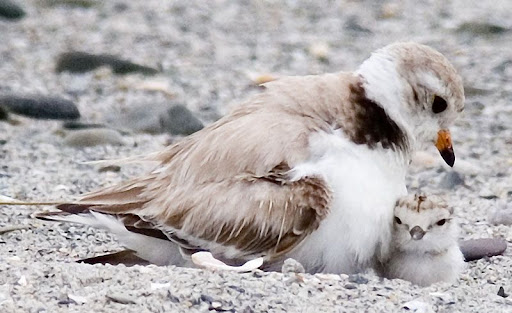 Back in the summers of 1999, 2000, and 2001 (and briefly in 2005), I strolled along the beaches of Long Island and New York City monitoring the breeding of the endangered Piping Plover. When it comes to getting to know a bird, it doesn't get much more familiar than I was able to get with these little tan puffballs.
Back in the summers of 1999, 2000, and 2001 (and briefly in 2005), I strolled along the beaches of Long Island and New York City monitoring the breeding of the endangered Piping Plover. When it comes to getting to know a bird, it doesn't get much more familiar than I was able to get with these little tan puffballs.As soon as I heard the call this weekend at Jones Beach's West End, I instantly recognized what bird made it, and began scanning the uninterrupted expanse of sand for movement or a little of the black and white on the Piping Plover's plumage. Plovers avoid predators by squatting down in depressions in the sand and not moving, their camouflage being so effective that they are almost impossible to see. Only when this particular bird moved and began to tilt to the side letting its wing hang limply did I begin to see it. The "broken wing display" draws predators away from the nest in normal situations. In the presence of an experienced plover steward like myself, I expect the bird finds it disconcerting that its usual display results in me walking away from it and probably closer to the nest it is trying to protect.
I walked the expanse of the beach from one walkway to the Jetty, then back east to the next walkway. I only saw 13 species, but 4 were new for the year. Ocean side beach like this is a habitat I haven't been to this year, but need to come to more frequently as the season wears on. Now that we have passed the summer solstice, days will begin to get shorter and the birds in the far north will begin their long migrations back to the southern hemisphere. I hope to get back to the Long Island beaches for birding at least once a month this summer so I can catch the rest of these species.
| Row # | Species | Count | Location | S/P | Date |
| 121 | Willet | 2 | Jones Beach SP--West End | US-NY | 19-Jun-10 |
| 122 | Piping Plover | 13 | Jones Beach SP--West End | US-NY | 19-Jun-10 |
| 123 | Common Tern | 12 | Jones Beach SP--West End | US-NY | 19-Jun-10 |
| 124 | Least Tern | 8 | Jones Beach SP--West End | US-NY | 19-Jun-10 |
